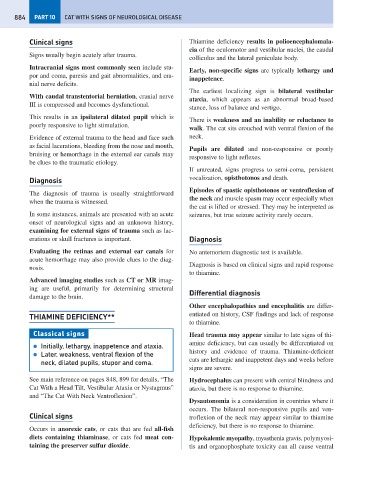Page 892 - Problem-Based Feline Medicine
P. 892
884 PART 10 CAT WITH SIGNS OF NEUROLOGICAL DISEASE
Clinical signs Thiamine deficiency results in polioencephalomala-
cia of the oculomotor and vestibular nuclei, the caudal
Signs usually begin acutely after trauma.
colliculus and the lateral geniculate body.
Intracranial signs most commonly seen include stu-
Early, non-specific signs are typically lethargy and
por and coma, paresis and gait abnormalities, and cra-
inappetence.
nial nerve deficits.
The earliest localizing sign is bilateral vestibular
With caudal transtentorial herniation, cranial nerve
ataxia, which appears as an abnormal broad-based
III is compressed and becomes dysfunctional.
stance, loss of balance and vertigo.
This results in an ipsilateral dilated pupil which is
There is weakness and an inability or reluctance to
poorly responsive to light stimulation.
walk. The cat sits crouched with ventral flexion of the
Evidence of external trauma to the head and face such neck.
as facial lacerations, bleeding from the nose and mouth,
Pupils are dilated and non-responsive or poorly
bruising or hemorrhage in the external ear canals may
responsive to light reflexes.
be clues to the traumatic etiology.
If untreated, signs progress to semi-coma, persistent
Diagnosis vocalization, opisthotonos and death.
Episodes of spastic opisthotonos or ventroflexion of
The diagnosis of trauma is usually straightforward
the neck and muscle spasm may occur especially when
when the trauma is witnessed.
the cat is lifted or stressed. They may be interpreted as
In some instances, animals are presented with an acute seizures, but true seizure activity rarely occurs.
onset of neurological signs and an unknown history,
examining for external signs of trauma such as lac-
erations or skull fractures is important. Diagnosis
Evaluating the retinas and external ear canals for No antemortem diagnostic test is available.
acute hemorrhage may also provide clues to the diag-
Diagnosis is based on clinical signs and rapid response
nosis.
to thiamine.
Advanced imaging studies such as CT or MR imag-
ing are useful, primarily for determining structural Differential diagnosis
damage to the brain.
Other encephalopathies and encephalitis are differ-
THIAMINE DEFICIENCY** entiated on history, CSF findings and lack of response
to thiamine.
Classical signs Head trauma may appear similar to late signs of thi-
amine deficiency, but can usually be differentiated on
● Initially, lethargy, inappetence and ataxia.
history and evidence of trauma. Thiamine-deficient
● Later, weakness, ventral flexion of the
cats are lethargic and inappetent days and weeks before
neck, dilated pupils, stupor and coma.
signs are severe.
See main reference on pages 848, 899 for details, “The Hydrocephalus can present with central blindness and
Cat With a Head Tilt, Vestibular Ataxia or Nystagmus” ataxia, but there is no response to thiamine.
and “The Cat With Neck Ventroflexion”.
Dysautonomia is a consideration in countries where it
occurs. The bilateral non-responsive pupils and ven-
Clinical signs troflexion of the neck may appear similar to thiamine
deficiency, but there is no response to thiamine.
Occurs in anorexic cats, or cats that are fed all-fish
diets containing thiaminase, or cats fed meat con- Hypokalemic myopathy, myasthenia gravis, polymyosi-
taining the preserver sulfur dioxide. tis and organophosphate toxicity can all cause ventral

